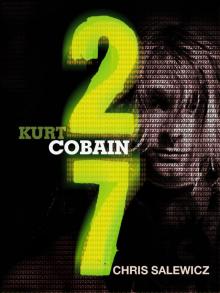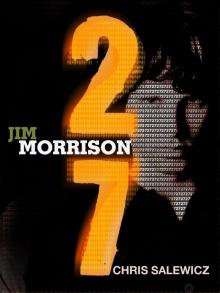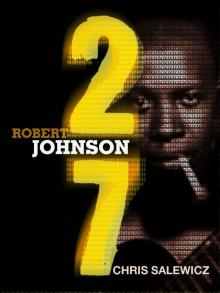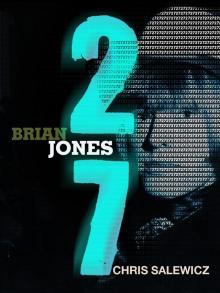- Home
- Salewicz, Chris
27: Jim Morrison Page 2
27: Jim Morrison Read online
Page 2
Whatever transpired, as the finely pitched vocalist with The Doors, Jim Morrison took on that shamanistic role of an animal deity, in his case that of The Lizard King. He expressed this on their third album, Waiting for the Sun, in the song ‘Not to Touch the Earth’: ‘I am the Lizard King / I can do anything.’ The lizard’s ability to shed its skin may have had some connection to the leather trousers he would constantly wear. Jim Morrison had also discovered he had an anagrammatic alter ego, Mr Mojo Risin’, which he employed in his song LA Woman. It was a name that above all else suggested the male libido and the virility of the penis. According to author James Riordan,9 Doors producer Paul Rothchild recalled that in the recording studio it was not unknown for an invariably drunk Jim Morrison to be found ‘involuntarily talking in tongues’. ‘The shaman,’ said Morrison, ‘was a man who would intoxicate himself. He was probably already an unusual individual. And he would put himself into a trance by dancing, whirling around, drinking, taking drugs – whatever. Then he would go on a mental travel and describe his journey to the rest of the tribe.’10
Jim Morrison began his studies in Los Angeles in February 1964, the month after the Beatles had so tumultuously arrived in the United States. But it was also six weeks after the death in the city of one of his inspirations, Aldous Huxley, the British author of the dystopian Brave New World. Huxley had died on the same day that President John F. Kennedy was murdered in Dallas, Texas. Relocating in 1948 to the then lotus land of southern California, Huxley had become a pioneering participant in consciousness-expanding experiments involving the ingestion of mescaline, peyote, and, later, LSD. In 1954 he had published an account of such experiments in his book The Doors of Perception.
Part of Jimmy Morrison’s reason for beginning studies at UCLA in the then brand new discipline of film studies was to avoid compulsory service in the US military. The month that he commenced his UCLA studies, Jimmy had been obliged to visit his father in San Diego, where the USS Bonhomme Richard was docked. Although clad in appropriately preppy clothing, his hair neatly trimmed, he was immediately ordered by his father to attend the ship’s barber for a further haircut.
At UCLA Jim Morrison began his course in film production. ‘More than anything else,’ wrote James Riordan, ‘Morrison was interested in reaching the masses and film was the best medium he had found for it up to this time.’11
His reading expanded: as well as Nietzsche, he now loved the writing of Blake, Rimbaud, Kafka, Artaud and Baudelaire.12 The Greek historian Plutarch became a favourite, notably his writings on Alexander the Great. (Oliver Stone, who later made a film about the great Greek leader, was similarly entranced.) He also immersed himself in studying Greek tragedy, and the manner in which its effects were achieved. Soon Jim Morrison would take on the appearance of a Greek god, one that combined oddly with his gaucho look of black leather trousers and white lace shirts. For now, however, he was pudgily overweight and not immediately impressive to look at. Wanting to move with the cool set, a sign of his ambition, he hung out with older students, especially the circle of Felix Venable, with whom he began to drink excessively and ingest LSD. Another student to whom his peers looked up was Ray Manzarek, like Venable older than many of the other students on the film course. Manzarek had already completed his economics degree at DePaul University in Chicago, where he had been born and grown up, the son of Polish parents who had themselves recently moved to the Los Angeles area, to the suburb of Manhattan Beach. Initially he had signed up at UCLA for a law degree, but quickly switched courses. Manzarek was distinctly unimpressed with Morrison’s friendship with Venable, considering him ‘a plain, evil mind-fuck’. As a consequence of this friendship, Manzarek noted, Jim Morrison was ‘starting to act a little weird. It’s like those black demons were always there just waiting … and this guy happened to come along and swing the gate open, and they all came bowling out.’13
On their course was an impressive cast list of instructors: among the teachers was Jean Renoir, director of the classic La Regle du Jeu. He was succeeded by Josef von Sternberg. And Jim Morrison certainly was a serious student of what at the time he clearly intended to be his future craft, travelling in late 1964 the 400 miles to Berkeley, outside San Francisco, to a rare screening of Jean Genet’s thirty-minute film Un Chant d’Amour, a paean to gay love in prison. Ray Manzarek was also there. Although Manzarek and his girlfriend Dorothy were spending a few days in San Francisco, Morrison had travelled all the way simply for that short film. ‘Together, as if we were fated,’ wrote Manzarek. ‘In the same place, at the same time, for the same art. It was simply meant to be.’14 And it was not only esoteric foreign art films that bonded the pair: both Manzarek and Morrison were huge fans of the 1961 western One-Eyed Jacks, directed by Marlon Brando, rating it far higher than John Ford’s revered The Searchers. ‘We were all Dadaists in a way,’ considered Manzarek. ‘All a little mad, a little over the top, and all in love with life … Jim was a poet. I was the jazzer-musician-blues guy.’15
Ray Manzarek noted that Jim Morrison lived in a nice apartment on Goshen Avenue, near the Veterans Hospital complex on Wilshire and San Vicente. ‘Obviously his mother and father had a couple of bucks,’ thought Manzarek.16 His book shelves bulged with the tomes of the era: French existentialists such as Sartre, Camus and Genet, as well as cultural reading list American standards like Fitzgerald, Hemingway, Faulkner and the more recent Norman Mailer. Jim Morrison was also partial to the Beat poets, and the highly stylized work of Louis-Ferdinand Céline, the French modernist novelist, whose Journey to the End of the Night was a clear influence on The Doors’ ‘End of the Night’. At his apartment, he and Manzarek would talk and drink beer and smoke pot. Jim was an excellent joint-roller, ‘little works of art’, according to Manzarek.17
Jim’s girlfriend from Clearwater, Florida, Mary Werbelow – who was stunningly beautiful, according to Manzarek – had followed him out to LA looking to fulfill her ambition to become a dancer. To Jim’s surprise, she had moved into her own place. Enrolling as a student at Los Angeles City College, she took a job as a go-go dancer, becoming ‘Gazzari’s Go-Go Girl of 1965’ at the club of the same name on the Sunset Strip – The Doors would play there the next year. Mary thought this was the start of her career, unaware that it was the highest point she would reach, and that Jim Morrison was tiring of her; their relationship ended when she came to see him and found him with another girl.
Meanwhile, Ray Manzarek, an experienced, classically trained pianist who was also into the blues and modern jazz, had started to play keyboards in a surf band, Rick and the Ravens, who had a regular spot in a Santa Monica bar. Manzarek performed under the stage-name of ‘Screamin’ Ray Daniels, the bearded blues-shouter’, and his five dollars a show earnings contributed to his tuition fees. One night, for no particular reason, he announced that audience member Jim Morrison, ‘a poet from UCLA film school’, would come up onstage and perform ‘Louie Louie’, a song that Morrison would facetiously and drunkenly call out for. ‘He was good. And he loved it. He bopped around and sang himself hoarse … That was the first time Jim Morrison ever sang onstage.’18
Their film course concluded in May 1965. Jim Morrison received his bachelor’s degree in cinematography despite the faculty’s rejection of the short film it was compulsory for all students to make. As though exemplifying Nietzsche’s aphorism that that which does not kill you will only make you stronger, Jim Morrison was the only student in his year to fail this area of his course. Ray Manzarek felt the faculty’s examiners simply did not get it: ‘It was cinematic poetry. It was a juxtaposition of images that really didn’t have any relationship to one another in a linear, narrative form. But after five minutes went by, it became a collective ‘whole’. It became a poetic piece. I thought it was excellent.’19
At the end of their film course, Jim Morrison told Ray Manzarek he was intending to move to New York. Manzarek, however, told Jim his plan was to remain in LA, to make a career as a filmmaker. Gradually it dawned on Ma
nzarek, however, that – despite his time studying – he knew no one who was actually making a living in the Hollywood movie business and had no idea how to get started. For the time being, finances were not too tight for him. Dorothy Fujikawa, his girlfriend, had basic employment, cleaning computer tape. In that post-UCLA comedown, Ray Manzarek was undergoing something of an existentialist crisis about his future. He sought to heal this by working on his tan at Venice beach.20
Down on the sand one day, he suddenly saw what appeared to be a vision walking towards him: Jim Morrison, dressed only in cut-off jeans, looking like a Greek god. The chubby boy from UCLA had lost thirty pounds and now looked tremendous. He had achieved this weight loss by the simple expedient of not eating and, instead, ingesting LSD. And he had been living on the roof of an abandoned Venice office block. To Manzarek’s surprise, Morrison declared he been ‘writing some songs’.21 Responding to Manzarek’s cajoling, Jim Morrison sang him one of these, ‘Moonlight Drive’, a song of death, as expressed in its final lines: ‘Baby, gonna drown tonight / Goin’ down, down, down.’ In other words, the first song of his that Morrison performed for Ray Manzarek anticipated his own end. And then he sang him a second song, ‘My Eyes Have Seen You’. Then a third: ‘Summer’s Almost Gone’.
It was an inspirational burst of songwriting. Immediately, Manzarek told him they were going to form a group together, but Morrison wondered at first who would be doing the singing; clearly he lacked any belief in his own vocal abilities. Reassured by the keyboard player of his talent, Morrison was persuaded to move into the tiny Ocean Park apartment in which Manzarek and his girlfriend lived.
Both former film students were serious consumers of LSD and marijuana – major pot-heads. After Morrison had told Manzarek what the name of their group should be – The Doors, taken from the title of Aldous Huxley’s book The Doors of Perception, in turn taken from William Blake’s poetic line ‘If the doors of perception were cleansed everything would appear to man as it is … infinite’ – they decided that the sound of their group should be psychedelic, a new concept at that time. What they needed was more musicians – as yet they lacked a guitar player and drummer. For a guitarist, Ray Manzarek wanted a player who was a rocker but with a knowledge of jazz – ‘Les Paul/Chuck Berry by way of Charlie Christian.’22
A principal reason that Jim Morrison had wanted to study at UCLA was because it was in California, renowned since the Second World War for the most cutting edge, and sometimes downright eccentric, thinking in the United States. It was where the most extreme elements of Western culture and philosophy collided with that of the East, the next stop across the Pacific.
Maharishi Mahesh Yogi, the founder of Transcendental Meditation, arrived in Los Angeles in 1965 on his proselytizing world tour. Attracted by what he had learned about the Maharishi’s simple meditation techniques, Ray Manzarek attended his series of lectures in Pacific Palisades, in west Los Angeles. There he encountered drummer John Densmore and guitarist Robby Krieger, who had already played together in a group, the Psychedelic Rangers. (Long before the Beatles’ interest in the Maharishi’s philosophy, therefore, The Doors’ three instrumental musicians became followers of Transcendental Meditation, and continued to be so.) At first it was only John Densmore who joined up with Ray Manzarek and Jim Morrison. He suggested they rehearse together and see what happened.
In addition to being the closest geographical point in the mainland USA to Eastern philosophy, California was also the nearest American location to Vietnam, where Jim Morrison’s father was stationed, soon to be an admiral in the burgeoning undeclared war. Now no longer a student, Jim Morrison was automatically eligible for the draft. (Ray Manzarek had already served his spell in the US military.) Although the assorted drugs Jim had consumed prior to his physical had little effect, when he declared (as Jimi Hendrix had done to escape the service in which he had already enlisted) that he was a homosexual, he was immediately excused from serving.23
Jim Morrison’s future was now clear. Early rehearsals took place at Ray Manzarek’s parents’ Manhattan Beach home: initially they were also working with the keyboard player’s brothers, Rick Manzarek (guitar) and Jim Manzarek (harmonica).
Before the four piece had ever played a live date they recorded a demo tape, in three hours, at World Pacific Studios on Third Street in downtown Los Angeles. The demo contained several songs, notably a tune called ‘Hello, I Love You’, which Jim had dreamed up when a gorgeous black girl had walked past Ray Manzarek and himself on Venice Beach. Then there were ‘Moonlight Drive’, ‘Summer’s Almost Gone’ and ‘My Eyes Have Seen You’ – the three songs Jim had sung the keyboard player when they met on Venice Beach – as well as a couple of new numbers: ‘End of the Night’, and ‘A Little Game (Go Insane)’.
Together they shopped their demo around the record labels of Los Angeles, largely encountering utter indifference or downright disdain. They went for a meeting with Lou Adler at ABC Dunhill; as he had signed The Mamas and the Papas, they had great respect for him. But he was dismissive of their work: ‘Nothing here I can use.’ ‘That’s okay, man. We don’t want to be used, anyway,’ Jim Morrison immediately punched back.24 (Ray Manzarek felt they later paid for that remark by Jim. Lou Adler became one of the promoters of 1967’s legendary Monterey Pop Festival – although by then a major break-out act in the United States, The Doors were never invited to play the event.)
At Columbia Records, however, the four musicians fared far better. Newly appointed to the A&R department, with a brief to develop new acts, Billy James at Columbia gave them a deal of sorts. ‘They had a quality that attracted me to them immediately. I guess they appealed to the snob in me because they were UCLA graduates and I thought, “Great, here are some intellectual types getting involved with rock ’n’ roll.” … The music was so raw, so basic, so simplistic, so unlike anything I was familiar with.’25
As Columbia owned Vox, the instruments manufacturer, James gave his newly signed musicians carte blanche at Vox’s warehouse in the San Fernando Valley. Ray Manzarek kitted himself out with a free Vox organ and amplifier.
Yet nothing more seemed to happen at Columbia for The Doors. Unbeknownst to them, Billy James had run into difficulties at the label. Newly promoted to A&R from Columbia’s publicity department, he felt he lacked sufficient production experience to do credit to his new signings, and the company’s more seasoned producers were all tied up with their own projects. Losing faith with the label, Ray Manzarek’s brothers quit the group. This was when the guitarist Robby Krieger, whom the keyboard player had also met at the Transcendental Meditation centre, was pulled in. Trained in both classical and jazz guitar, he had experienced an epiphany when he saw Chuck Berry perform at Santa Monica Civic, immediately trading in his classical instrument for a Gibson SG, the identical guitar played by Berry. Not unconnected to his fondness for Eastern mysticism, he had also become an adept on the sitar, courtesy of lessons at the Los Angeles Ravi Shankar school.
They found space for practising in Santa Monica, in a garage behind the bus depot. Soon Ray Manzarek took a small apartment in nearby Venice, where they could rehearse all day. A cloud of marijuana smoke hung over their rehearsals. Permanently high on powerful weed, The Doors found their sound quickly. ‘Robby’s bottleneck guitar was snake-weaving us into the fourth dimension, into a higher, expanded state of consciousness. We had gone primordial and cosmic at the same time,’ wrote Manzarek.26 Then Robby Krieger came up with the structure of a simple song that soon turned into a tune called ‘Light My Fire’.
Of these times, Jim Morrison later recalled: ‘In the beginning we were creating our music, ourselves, every night … starting with a few outlines, maybe a few words for a song. Sometimes we worked out in Venice, looking at the surf. We were together a lot and it was good times for all of us. Acid, sun, friends, the ocean, and poetry and music.’27
They auditioned for a bass player, but then Ray Manzarek discovered the Fender-Rhodes keyboard bass. The instrument also
gave great freedom to John Densmore’s drumming.
In January 1966 Jim Morrison, his UCLA friend Felix Venable, and Philip O’Leno, whom they both knew from the same college, declared their intention to drive to Mexico, only 100 miles distant, where they would commune with Native American sages and consume peyote. It is more likely that they only got as far as New Mexico, however. Somewhere along the way, while pulled up at a red stop light, Jim Morrison jumped out of their vehicle, ran over to a Mexican-American girl, kissed her on the mouth, and then leapt back into the car. Returning to Los Angeles, Jim Morrison and Felix Venable were covered in bruises; Jim told a patently untrue story of how they had beaten Phil O’Leno to death, leaving him in a riverbed. On hearing this, O’Leno’s father had Jim Morrison arrested and slung into jail. He was soon bailed, and the case fell apart when O’Leno surfaced in Los Angeles. Later, it was suggested that all three had been beaten by police in New Mexico, or that O’Leno and Jim Morrison had come to blows over a girl.
In February 1966 The Doors auditioned for an utterly undistinguished club on the Sunset Strip, the London Fog. It had virtually no audience, apart from local hookers and alcoholic lowlife. But they got the gig, beginning later that month. Playing from Thursday to Sunday, The Doors performed five sets a night, for ten dollars each. (A go-go dancer, one Rhonda Lane, would dance in a cage as they played.) As had the Beatles’ similar stints in Hamburg nightclubs, the rigour of these sets honed The Doors into a fine rock ’n’ roll machine, especially Jim Morrison, whose initially weak vocals were becoming far stronger. He was also losing his nervousness over performing – at first he would sing with his back to the audience. ‘All that singing was exercising his throat muscles and they were getting strong and thick,’ wrote Ray Manzarek.28

 27: Kurt Cobain
27: Kurt Cobain 27: Jim Morrison
27: Jim Morrison 27: Robert Johnson
27: Robert Johnson 27: Brian Jones
27: Brian Jones